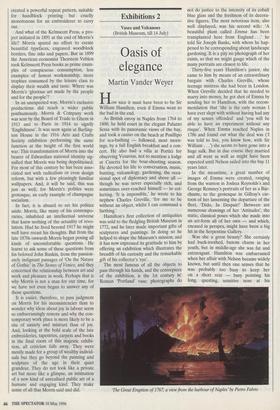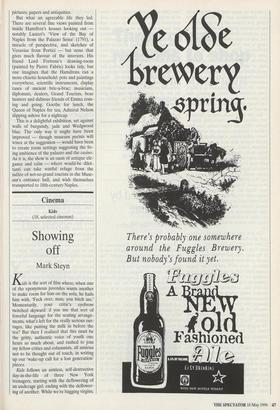Exhibitions 2
Vases and Volcanoes (British Museum, till 14 July)
Oasis of elegance
Martin Vander Weyer
How nice it must have been to be Sir William Hamilton, even if Emma went to the bad in the end.
As British envoy in Naples from 1764 to 1800, he held court in the elegant Palazzo Sessa with its panoramic views of the bay, and took a casino on the beach at Posillipo for sea-bathing — followed, most morn- ings, by a full English breakfast and a con- cert. He also had a villa at Portici for observing Vesuvius, not to mention a lodge at Caserta for the boar-shooting season. He devoted his life to conversation, music, hunting, vulcanology, gardening, the occa- sional spot of diplomacy and above all though he was never especially rich, and sometimes over-reached himself — to col- lecting. 'It is impossible,' he wrote to his nephew Charles Greville, 'for me to be without an object, whilst I can command a farthing.' Hamilton's first collection of antiquities was sold to the fledgling British Museum in 1772, and he later made important gifts of sculptures and paintings. In doing so he helped to shape the Museum's mission, and it has now expressed its gratitude to him by offering an exhibition which illustrates the breadth of his curiosity and the remarkable gift of his collector's 'eye'.
The most famous of all the objects to pass through his hands, and the centrepiece of the exhibition, is the 1st century BC Roman 'Portland' vase: photographs do not do justice to the intensity of its cobalt blue glass and the freshness of its decora- tive figures. The most notorious item, also well displayed, was his second wife: 'A beautiful plant called Emma has been transplanted here from England . . .' he told Sir Joseph Banks, with whom he hap- pened to be corresponding about landscape gardening. It is a pity no photograph of her exists, so that we might gauge which of the many portraits are closest to life.
Thirty-five years Hamilton's junior, she came to him by means of an extraordinary bargain with Charles Greville, whose teenage mistress she had been in London. When Greville decided that he needed to marry into money, he got shot of Emma by sending her to Hamilton, with the recom- mendation that 'she is the only woman I have ever slept with without having had any of my senses offended' and 'you will be able to have an experiment without any risque'. When Emma reached Naples in 1786 and found out what the deal was CI was told to live, you know how, with Sir William . . .') she seems to have gone into a huge sulk. But in due course they married and all went as well as might have been expected until Nelson sailed into the bay 11 years later.
In the meantime, a great number of images of Emma were created, ranging from the wanton in Joshua Reynolds's and George Romney's portraits of her as a Bac- chante, to the grotesque in Gillray's car- toon of her lamenting the departure of the fleet, 'Dido, In Despair!' Between are numerous drawings of her 'Attitudes', the static, classical poses which she made into an art-form all of her own — and which, encased in perspex, might have been a big hit in the Serpentine Gallery.
Was she a great beauty? She certainly had buck-toothed, buxom charm in her youth, but in middle-age she was fat and extravagant. Hamilton was embarrassed when her affair with Nelson became widely known, but until then one senses that he was probably too busy to keep her on a short rein — busy pointing his long, questing, sensitive nose at his `The Great Eruption of 1767, a view from the harbour of Naples' by Pietro Fabris pictures, papers and antiquities.
But what an agreeable life they led. There are several fine views painted from inside Hamilton's houses looking out notably Lusieri's 'View of the Bay of Naples from the Palazzo Sessa' (1791), a miracle of perspective, and sketches of Vesuvius from Portici — but none that gives much flavour of the interiors. His friend Lord Fortrose's drawing-room (painted by Pietro Fabris) looks tidy, but one imagines that the Hamiltons ran a more chaotic household: pots and paintings everywhere, scientific instruments, display cases of ancient bric-a-brac; musicians, diplomats, dealers, Grand Tourists, boar hunters and dubious friends of Emma com- ing and going; Goethe for lunch, the Queen of Naples for tea, Admiral Nelson slipping ashore for a nightcap.
This is a delightful exhibition, set against walls of burgundy, jade and Wedgwood blue. The only way it might have been improved — though museum purists will wince at the suggestion — would have been to create room settings suggesting the liv- ing ambience of the palazzo and the casino. As it is, the show is an oasis of antique ele- gance and calm — where would-be dilet- tanti can take wistful refuge from the melee of not-so-grand tourists in the Muse- um's entrance hall, and wish themselves transported to 18th-century Naples.



































































 Previous page
Previous page